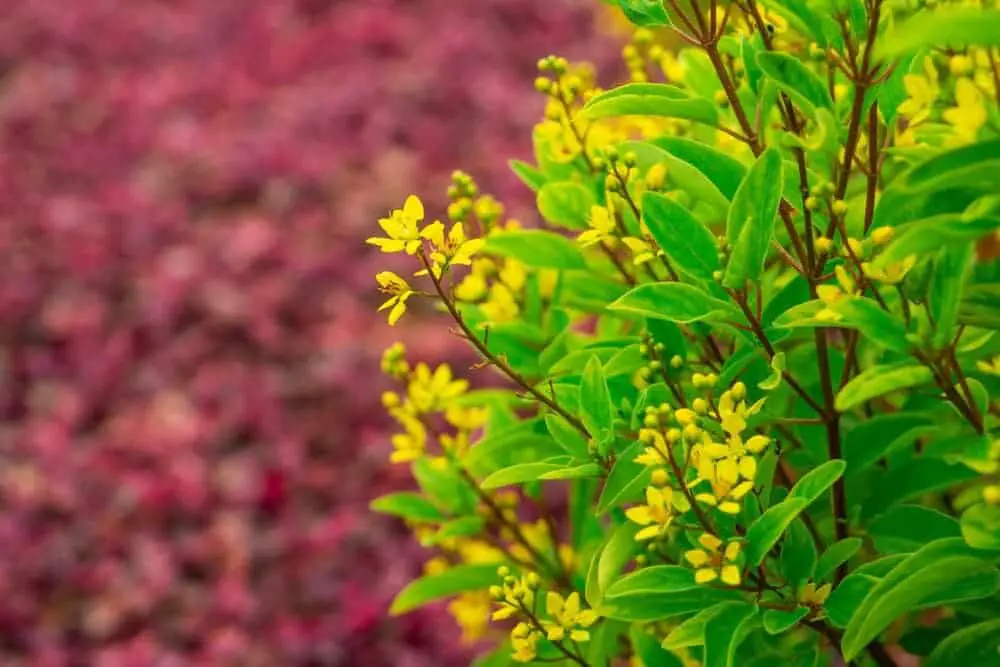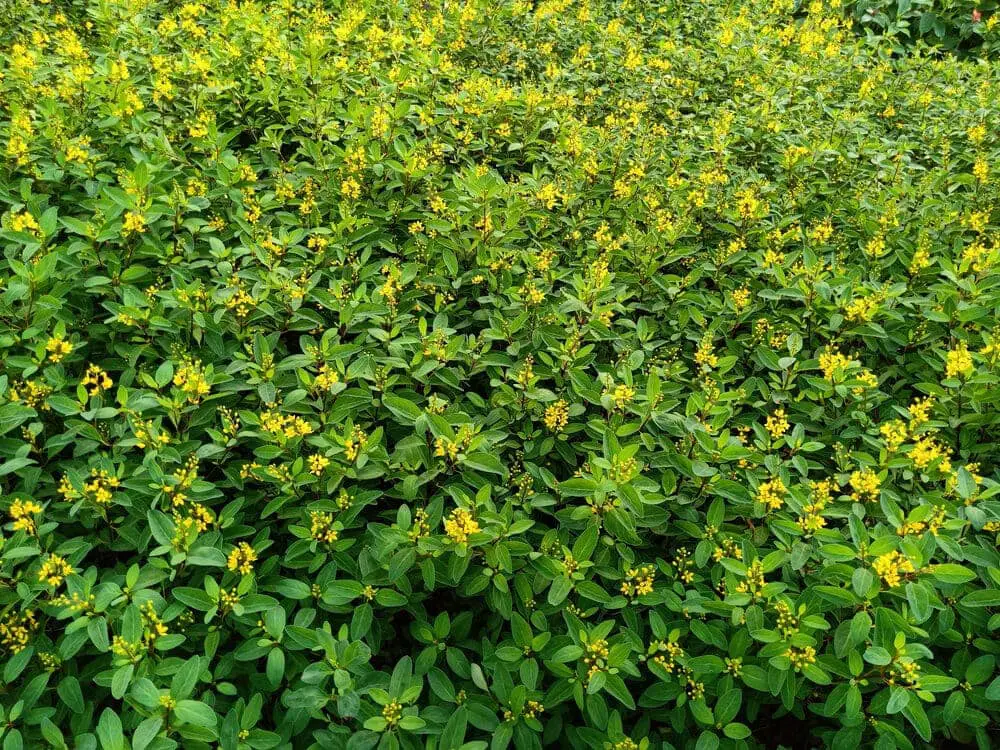The Thryallis plant offers the perfect addition to just about any garden. You will quickly discover just how beautiful and easy to care for it is.
It is, however, important that you take the time to learn as much as possible about it. This information will allow you to nurture your plant properly.
Thryallis Plant Care & Growing Guide
1. Light Requirement
If you are going to grow one of these plants, you need to keep in mind that they do best when exposed to direct natural sunlight. While these plants can survive in partial shade, it is not ideal. The less sun this plant gets, the more likely it is to droop and not produce as many flowers.
2. Water
You’ll need to water this plant on a regular basis while you are still in the process of establishing it. After you have accomplished this, you can wait until the soil is somewhat dry before watering again.
These plants are drought-tolerant and can quickly die if they are watered too much or too frequently. If the soil still feels moist, you’ll want to put off watering it for a little bit longer. This will help with preventing root rot, which can quickly kill your plant.
3. Climate
The Thryallis plant does best in sub-tropical regions. This is why you are likely to see a lot of this plant in Florida. It can be grown in hardiness zones of 9 through 11. It is fairly common for people to use this plant as a hedge.
4. Soil
Make sure that you keep this plant in soil that drains well. There is no need to use any fertilizer. It is a good idea to use cow manure when planting seeds or seedlings though. This will encourage growth in a big way.

5. Temperature
You will be able to keep this plant outside year round, but it will die in the winter when temperatures get to below 24 degrees Fahrenheit. These plants come back to life at the beginning of spring.
While the plant itself will die in the winter, the roots will remain intact. This is ultimately what allows it to keep growing back when the weather gets warmer.
6. Repotting
When you are going about repotting your Thryallis plant, you will need to be very careful. It is very easy to damage the root system of this plant if you aren’t being gentle enough when transplanting it into a new container.
Make sure that the container you put your plant into is at least an inch or two larger than the one it is currently in. You also need to be mindful of the rootball, as it can get damaged if it is rootbound. Slowly and gently remove the roots from the rootball before lifting it out of its pot.
7. Speed of Growth
These plants can grow fairly quickly when they are consistently exposed to direct bright sunlight. You’ll need to keep in mind that they do not grow nearly as fast when kept in partial shade.
8. Height and Spread
You can expect this plant to grow up to nine feet tall and six feet wide without any trimming. This means that it is crucial for you to carefully select a spot outside where it can spread out and grow uninhibited.
You’ll want to keep these plants anywhere from 2.5 to 3 feet apart from each other to avoid overcrowding. The last thing you want is for their roots to get tangled up, which can cause a nightmare of a situation.
9. Flowers
The yellow flowers that this plant produces are quite spectacular. They have a golden coloration that will be sure to enhance the overall look of your garden.
These plants bloom throughout the spring, summer and autumn months in the northern regions of the U.S. Those who grow one of these plants in a warmer climate can expect to have these flowers all year round.
10. Trimming
Semi-regular trimming is needed to keep these plants from getting too large. Wait until it starts getting bigger than you’d like to begin pruning.

How to get Thryallis Plants to Flower
If you want to get your Thryallis plant to flower, it is important that you keep it in direct sunlight all day long. Sunlight is one of the big key factors when it comes to blooming with this plant. Growing this plant in partial shade will likely produce far fewer flowers, so you’ll need to keep that in mind.
A granular fertilizer in the spring, summer and autumn seasons can help this plant produce lots of flowers. You can also use bone meal or even a liquid fertilizer to achieve this outcome.
Common Thryallis Plant Diseases
One of the great things about this plant is that it doesn’t tend to attract many pests. Root rot can be a big concern with these plants though. You can avoid this issue by simply not watering the plant too much. Root rot develops as a result of overly moist soil, which saturates the roots and causes them to rot away.
Conclusion
- Thryallis plants tend to do best when they are kept in an area that receives bright and direct sunlight.
- While these plants can be grown in partial shade, it is not ideal.
- You’ll want to water these plants on a regular basis until they are established.
- When you have established your Thryallis plant, you’ll only need to water it once the soil becomes somewhat dry.
- You don’t want to water this type of plant if the soil still feels moist. This can lead to root rot.
- These plants are commonly grown in sub-tropical climates, which is why you will see a lot of them in Florida.
- Make sure that you use a well-draining soil when growing one of these plants.
- The yellow flowers this plant produces will be sure to enhance the overall beauty of your garden.
- One of the best ways to get this plant to flower is to use a granular fertilizer in the spring, summer and autumn seasons.
- Make sure that you trim this plant when it starts getting bigger than you’d like.

Victoria is the owner and main author of hobby plants. She loves spending her free time in her garden planting and taking care of her plants. Victoria hopes you enjoy the content here!
![Mother Of Thousands Plant [Complete Plant Care Guide] Mother Of Thousands Plant [Complete Plant Care Guide]](https://www.hobbyplants.com/wp-content/uploads/2022/07/mother-of-thousands-plant-300x158.jpg)
![Majesty Palm Plant Care: [Complete Beginner's Guide] Majesty Palm Plant Care: [Complete Beginner's Guide]](https://www.hobbyplants.com/wp-content/uploads/2022/08/majesty-palm-care-300x158.jpg)
![Exotic Angel Plant Care: [Complete Beginner's Guide] Exotic Angel Plant Care: [Complete Beginner's Guide]](https://www.hobbyplants.com/wp-content/uploads/2022/08/exotic-angel-plant-care-300x158.jpg)
![Snow White Waffle Plant: [Complete Care Guide] Snow White Waffle Plant: [Complete Care Guide]](https://www.hobbyplants.com/wp-content/uploads/2022/08/snow-white-waffle-plant-300x158.jpg)
![Waffle Plant Care: [Complete Beginner's Guide] Waffle Plant Care: [Complete Beginner's Guide]](https://www.hobbyplants.com/wp-content/uploads/2022/08/waffle-plant-300x158.jpg)
![Bird Of Paradise Plant Care: [Complete Beginner's Guide] Bird Of Paradise Plant Care: [Complete Beginner's Guide]](https://www.hobbyplants.com/wp-content/uploads/2022/08/bird-of-paradise-plant-300x158.jpg)
![Purple Passion Plant Care: [Complete Beginner's Guide] Purple Passion Plant Care: [Complete Beginner's Guide]](https://www.hobbyplants.com/wp-content/uploads/2022/08/purple-passion-plant-care-300x158.jpg)
![China Doll Plant Care: [Complete Beginner's Guide] China Doll Plant Care: [Complete Beginner's Guide]](https://www.hobbyplants.com/wp-content/uploads/2022/09/china-doll-plant-care-300x158.jpg)
![Polka Dot Plant Care: [Complete Beginner's Guide] Polka Dot Plant Care: [Complete Beginner's Guide]](https://www.hobbyplants.com/wp-content/uploads/2022/09/polka-dot-plant-300x158.jpg)
![Mona Lisa Lipstick Plant Care: [Complete Beginner's Guide] Mona Lisa Lipstick Plant Care: [Complete Beginner's Guide]](https://www.hobbyplants.com/wp-content/uploads/2022/09/lipstick-plant-mona-lisa-300x158.jpg)
![Yucca Cane Plant Care: [Complete Beginner's Guide] Yucca Cane Plant Care: [Complete Beginner's Guide]](https://www.hobbyplants.com/wp-content/uploads/2022/09/yucca-cane-plant-care-300x158.jpg)
![Bush On Fire Croton Plant Care: [Complete Beginner's Guide] Bush On Fire Croton Plant Care: [Complete Beginner's Guide]](https://www.hobbyplants.com/wp-content/uploads/2022/09/bush-on-fire-croton-300x158.jpg)